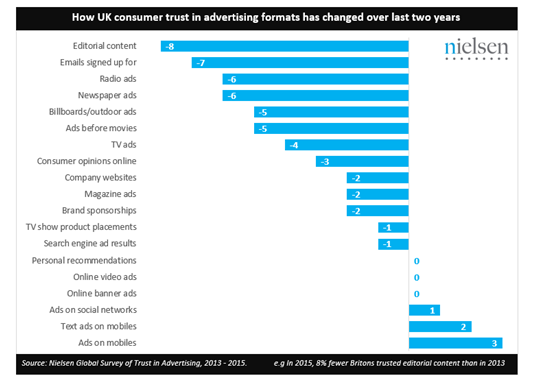Are you struggling to maintain previous levels of sales, or having issues generating leads? If you are simply doing more of the same, it could be that your whole approach is the problem. The entire marketing and buyer landscape has changed – old methods no longer work. Unless you recognise this and change your strategy, your sales will suffer and problems will follow.
The evidence for the revolution
You may have heard the saying: "If you have been doing something the same way for a long period of time – it's probably wrong."
When Adobe carried out a survey in 2013, they found that 76 per cent of people felt that marketing had changed more in the past two years than in the previous 50, with a similar number saying that the old marketing model is no longer sufficient. There are a whole host of factors – technological, social, and more – that are accelerating this rate of change.
So, if you haven't changed your B2B marketing tactics in the past few years, you need to rethink - or lose potential sales.
Nobody in B2B talks directly to a sales person anymore as a first step. Modern buyers hate being sold to and pressurised. But in the past, the sales person was the ONLY source of information, so buyers had no choice but to call them. Now, buyers are doing their own research online and they are in control of the sales process. In fact, 74 per cent of business buyers conduct more than half of their research online before making an offline purchase (Forrester).
As a generation, we are more immune to advertising and direct marketing messages than ever before, with the effectiveness of old school "interruption" marketing reducing yearly. Nielsen's 2015 Global Survey of Trust in Advertising found that, in the UK, of the 19 ad formats covered in the report, only three – mobile ads, text ads on mobiles, and ads on social networks – have increased in trust over the last two years. Thirteen experienced a decline, while three were unchanged.

A massive 91 per cent of people say that ads are more intrusive today than a year ago. Many web users have resorted to installing ad blockers, with mobile ad blocking increasing by 90 per cent in 2016 (Hubspot).
Paid advertising (print, outdoor) is consistently reported as the most overrated marketing tactic by marketers. In 2016, over 30 per cent of people rated paid advertising the most overrated tactic, more than double the second most overrated tactic – paid online advertising (Hubspot).
The statistics making the case for social marketing
Unless you have been holed up in a bunker for the past ten years, you can't have failed to notice that social media has had a massive impact on marketing strategy. And if you think it's just for B2C brands, take a look at some of these statistics regarding LinkedIn – rated the most effective social network for B2B (Hubspot).
According to a survey from DemandWave, B2B marketers say that white papers (61 per cent) and LinkedIn (59 per cent) are the most effective digital content and social media tactics for generating leads.
- Half of all LinkedIn users are likely to buy from a company having previously engaged with them on the platform (LinkedIn).
- 80 per cent of LinkedIn members want to connect with a company to boost their professional decision making (LinkedIn).
- 94 per cent of B2B marketers use LinkedIn to distribute content (Content Marketing Institute).
- 66 per cent of B2B marketers rank LinkedIn as the most effective social media platform for their business (Content Marketing Institute).
Data supports a content marketing approach.
It seems to be almost second nature now for all of us, when we want to know how to approach a problem, we turn to social media or the web – for example, "how to" searches on YouTube are up 70 per cent year over year (Google 2015).
So, with buyers now conducting their own research and looking for information and solutions from peers, social media and the web, B2B companies have to ensure that they have useful, engaging content out there for buyers to find. According to DemandGen, 47 per cent of B2B buyers digest three to five pieces of content before communicating with a sales person.
But is content marketing really effective? Can writing a blog, for instance, really provide leads and drive sales?
The data strongly suggests it can and does. Hubspot, the inbound marketing specialists, have significant data from comprehensive research in this area and they found that companies that blog have 97 per cent more inbound links than those who don't. With further evidence suggesting that 82 per cent of marketers who blog see positive ROI from their inbound marketing, delivering 54 per cent more leads into the marketing funnel than traditional outbound marketing.
Furthermore, inbound marketing can actually work out more cost-effective than outbound - using inbound tactics saves an average of 13 per cent in overall cost per lead (Hubspot).
Because being found is crucial, search engine marketing (SEM) is one area where advertising is still important and budgets are increasing in line with results, with 55 per cent of B2B marketers reporting that SEM is their most effective paid advertising method (MarketingProfs).
Likewise, once a buyer finds your content, they have to be able to access it easily. You might think this would be a given, but with an increasing number of buyers accessing B2B content on mobile devices and websites not always optimised for mobile, it's a real issue.
It's frightening to think that 62 per cent of users will leave a mobile site if the navigation isn't clear or easy to use and 72 per cent of users will leave a mobile site if it loads too slowly (Search Engine Watch).
So, making sure your content is mobile-friendly is a priority. And it is not just access: 57 per cent of users say they won't recommend a business with a poorly-designed mobile site (CMS Report). This is doubly important now that buyers are consulting with their peers for information and recommendations.
Buyer's journey now the crucial factor
Creating an integrated strategy and an approach that encompasses sales and marketing working together to support every stage of the buyer's journey, from research to after-sales care, is the key to gaining sales. Case studies have revealed that such an approach provides a competitive advantage, in some cases doubling sales year over year (Harvard Busines Review).
This focus on the customer journey is one of the biggest areas to change – if you can mobilise your company to embrace this culturally, then you will have an edge. Although 86 per cent of senior-level marketers say that it's critical or very important to create a cohesive customer journey, only 23 per cent of B2B marketers claim to have a customer-centric – versus a channel- or product-centric – organisational structure. Only 17 per cent said their company had fully integrated their customer data across all areas of the organisation (State of B2B Marketing, Salesforce).
An Oracle survey released this month found that 34 per cent of brands admit their sales, marketing and customer service teams work completely independently of each other, leading to a lack of customer insight, with 33 per cent blaming it on their current systems and technologies, and 30 per cent saying their corporate culture makes it tricky for sales and marketing teams to align priorities. Moving forward, achieving alignment between your sales and marketing teams is key.
With 65 per cent of B2B companies saying that their highest priority is generating traffic and leads (Hubspot), getting your marketing to deliver is a challenge that everyone faces. Reviewing your B2B marketing strategy, to ensure it is up to date and reflects the latest thinking and research, will lead to sales success. Right now, that means letting go of old outbound, sales-led tactics and focusing on inbound marketing and useful content.


